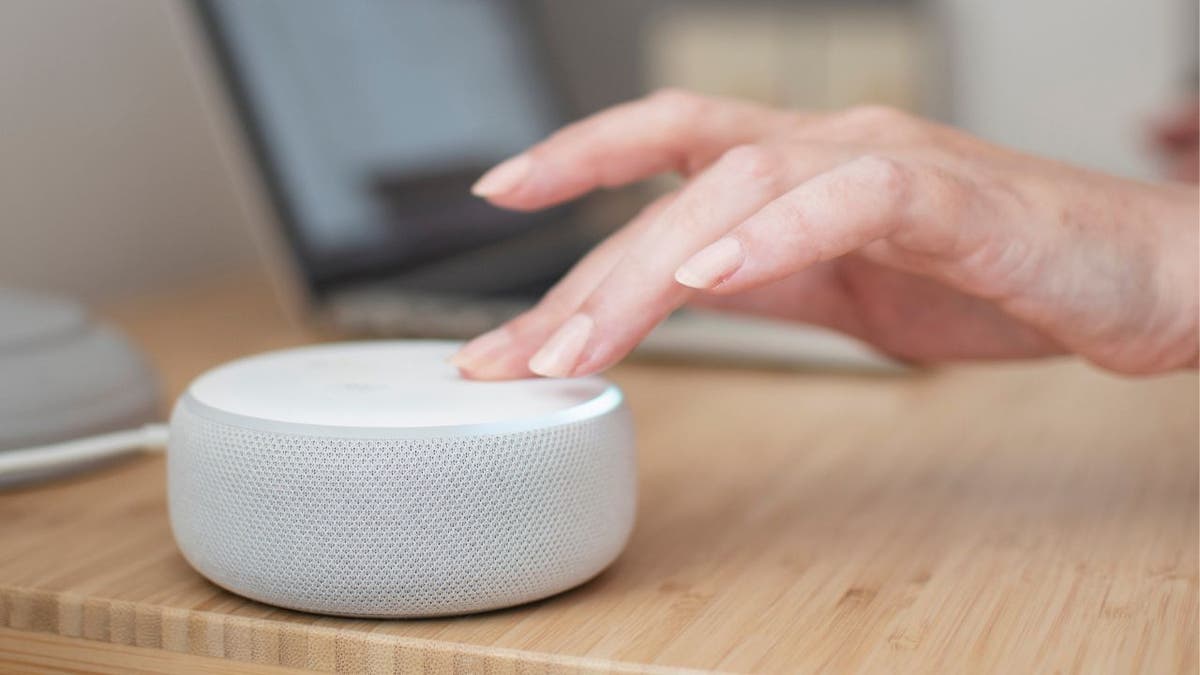The term “endgame,” among keyboard enthusiasts, is sort of a running gag. Endgame is when you finally dial in your perfect layout, case, features, switches, and keycaps, so you can stop noodling around with parts and get on with whatever it is you actually use the keyboard for — work, presumably. Then a few months later you see something shiny and start over.
Technology
To do: Change your smart speaker settings before the holidays

When we have friends and family with kids over, voice assistants can become a favorite attraction. At best, someone will start another “Baby Shark” round, and you’ll sing it for a week.
But what if one of those curious kiddos buys toys with your Amazon Echo? Or maybe your niece, Alexis, will have the Echo going haywire.
That’s why it’s worth changing a few settings to make your voice assistants safer when guests come knocking. Do it now before the holiday rush!
YOUR SMART ASSISTANT IS LISTENING, BUT DOES THAT IMPACT THE ADS YOU SEE?
Psst, I’m giving away an iPhone 15 (a $799 value)! Try my free daily tech newsletter just once and you’re entered to win. Good luck!
Keep kids from shopping on voice assistants
Tech-adventurous toddlers can order things with voice commands before anyone can stop them. That’s a massive pain in the wallet and can take lots of service calls to untangle … and yes, it’s more likely to happen around the holidays.
HomePod mini. (Credit: Apple)
Frankly, I’m more comfortable turning voice purchasing off unless it’s on something private like my phone. Since Amazon is a big culprit here, it’s a good thing you can prevent Alexa from going on a shopping spree.
- Open the Alexa app, select More > Settings, then go to Account Settings.
- Here, you can find the Voice Purchasing menu, where you can turn voice purchasing capabilities off entirely.
- You can also set up codes to use voice purchasing, but only if you know the passcode.
Google Assistant lets you do something similar to the Payments section in your account. Voice payments aren’t on by default, but you can turn them off here if you’ve set them up before.
HOW TO DIG UP DIRT ABOUT YOURSELF ONLINE
Know your mute buttons
Manufacturers include physical mute buttons on every voice assistant device because they care about our privacy. No, they just do it so they can say they care.
When you have guests and it looks like over-indulgence in voice commands (and/or cocktails) could be a problem, tap mute to stop any commands. Look for the crossed-out speaker icon. For displays, an accompanying switch flips the camera off, too … just in case.
Set up parental controls
From explicit radio shows to downright adult content, there are probably a few things you don’t want voice assistants to search for when guests are around (or considering past privacy issues, ever). I have a few parental blocks that prevent this, no matter how naughty or rambunctious people get.

Smart speaker top view artificial intelligence assistant voice control blue ring finger (iStock)
Google Assistant has some of the best options, with an Assistant Parental Controls section for each child user, although this won’t affect new users.
Google Home has several app content filters in the Digital Wellbeing section, where you can add filters to specific devices to block unwelcome content.
If you use Alexa, open the app, select More and head to Settings. In the Music & Podcasts settings, you can find an Explicit Language Filter to enable.
Change your wake word to limit guest use
It’s understandable if you don’t want just anyone using your voice assistants, especially if you have personalized options — or it’s just too annoying.
DON’T WANT TO DROP $1K ON A NEW PHONE? DO THIS INSTEAD
One thing you could do is change the wake word. Bad news: You can’t do this with Siri or Google. Well, there are reports that Google Assistant responds to, “Hey, boobies” (really), but that’s probably not what you had in mind. If you use Apple or Google smart home gear, stick with mute.
If you use Alexa, you can change to another recognized wake word.
- Go to your Device in the Alexa app and select the settings icon in the upper right.
- Tap Wake Word and switch it to something more unique than Alexa. Options include Amazon, Computer, Echo and Ziggy. This time of year, Santa is an option, too.
For more info to help the privacy-conscious, I’ve got some tips on changing privacy settings to avoid being tracked during the holidays.

Try my free daily tech newsletter, The Current. Join 509,000 people who trust me, not AI and algorithms. Sign up, and you’ll be entered to win an iPhone 15 ($799 value). Good luck!
Keep your tech-know going
My popular podcast is called “Kim Komando Today.” It’s a solid 30 minutes of tech news, tips, and callers with tech questions like you from all over the country. Search for it wherever you get your podcasts. For your convenience, hit the link below for a recent episode.
PODCAST PICK: Cybertruck’s $50K Fee, hidden AirTag spots & TikTok hacks
Plus, what your social media credentials fetch on the dark web. Get a sneak peek at your coworker’s Google calendar. With the holidays looming, we spotlight top scams to dodge. And, insights into YouTube’s AI strategy and a quick fix for editing PDFs.
Check out my podcast “Kim Komando Today” on Apple, Google Podcasts, Spotify, or your favorite podcast player.
Listen to the podcast here or wherever you get your podcasts. Just search for my last name, “Komando.”
Sound like a tech pro, even if you’re not! Award-winning popular host Kim Komando is your secret weapon. Listen on 425+ radio stations or get the podcast. And join over 400,000 people who get her free 5-minute daily email newsletter.
Copyright 2024, WestStar Multimedia Entertainment. All rights reserved.

Technology
How to build the best keyboard in the world

In the search for endgame, most of us have to compromise somewhere — usually time or money. Sometimes the thing you’re looking for just doesn’t exist.
But what if you didn’t have to compromise? What if you had the time, the patience, the creative vision, and the cash to create your endgame keyboard from scratch? And I mean really from scratch, from the cable to the switches and stabilizers.
This is how you get the Seneca, the first keyboard from Norbauer & Co. It has a plasma-oxide-finished milled aluminum chassis, a solid brass switchplate, custom capacitive switches, the best stabilizers in the world (also custom), spherical-profile keycaps with appropriately retro-looking centered legends, zero backlighting, and a completely flat typing angle.
It weighs seven pounds and costs $3,600.
You might have some questions, like: Why is it $3,600? Who would make a keyboard that’s that expensive? And is it even any good?
I’ve spent the last couple of months typing on an early Seneca, and the answer to the last question is the easiest. Yes. It’s incredible. It’s certainly the nicest keyboard you can buy. The build quality is astonishing, the Topre-style switches are better than Topre’s, the stabilizers are better than anyone’s, and the keyboard is beautiful and a joy to type on. The Seneca is a genuine technical accomplishment.
The answer to the first two questions is Ryan Norbauer.
Ryan Norbauer is well known in the keyboard community for his aftermarket housings, but the Seneca is his first ready-to-type board. To hear him tell it, it’s the latest logical step in a decadelong process to build his own endgame keyboard, of which the business — Norbauer & Co. — is an almost accidental byproduct.

Norbauer grew up in West Virginia in the 1990s, watching Star Trek: The Next Generation and absorbing both its retro-modern aesthetic and its vision of an egalitarian, post-scarcity world. It was also the beginning of the personal computing era and the dawn of the internet. The computer represented an escape from the world as it is, a window into the future of Star Trek, of Epcot, of the idea that a more connected world would be a better one.
The Seneca represents Norbauer’s attempt to make the best possible computer keyboard, to his own standards and tastes, without worrying about cost — the kind of keyboard that looks and feels like we remember keyboards feeling, back when we thought computers were a good idea.
“A big part for me of the allure of keyboards is the connection to my childhood nostalgia about being really excited about computing,” Norbauer tells me via video chat. So the Seneca is big, chunky, and has a standard tenkeyless layout, rather than something more compact or exotic, because that’s what he’s always used, and what brings back that feeling. “I feel like I can more authentically make an optimal keyboard if the first one I make is exactly the one that I want.”
Norbauer has a habit of wanting things that don’t exist, then figuring out how to build them from scratch. About 20 years ago, he got an idea for a dating website. “I didn’t have any money at all. I dropped out of a PhD program and I just had this idea for a company I wanted to start and I couldn’t hire anyone to code it for me. So I’m like, ‘Okay, I guess I just have to learn how to code.’”
He spent six months coding for 14 hours a day; this got him a website, a startup, and tendonitis. Fixing the tendonitis involved adopting proper typing form (wrists straight, hands hovering over the keyboard like a pianist’s). Searching for a more comfortable keyboard eventually sent him down the path of an obsession.
The dating website led to two more startups. Selling all three startups in 2010 gave him the time and money to explore new interests: at first, learning some industrial design skills so he could make Star Trek prop replicas. It also led him to Topre keyboards.
Topre switches — most famously found in the Happy Hacking Keyboard — have a rubber dome under each key, instead of a physical switch. Pushing the key collapses the dome, which compresses a conical spring; a capacitive circuit under each key senses the change in capacitance and, at a certain threshold, registers a keypress. Releasing the switch snaps the dome back into place.
Topre keyboards are rare compared to mechanical keyboards using Cherry MX-style switches. Only a few companies ever made them, so there aren’t many layout options, and they tend to be more expensive, with fewer features for the money. They’re also harder to customize, with only a few different dome options; they also aren’t compatible with most aftermarket keycaps out of the box. And while metal cases are common in enthusiast mechanical keyboards, Topre keyboards only come in plastic. But Topre boards have a dedicated fan base because the domes give Topre switches a snappy tactility you can’t otherwise replicate.
By 2014, he was using a modified Topre Realforce 87u keyboard in an aftermarket aluminum housing. He was also designing a Star Trek-inspired keycap set. Like most aftermarket keycaps, it worked with Cherry MX-style mechanical switches; Topre boards have a different keycap mount. So he couldn’t use his Star Trek keycaps on his favorite keyboard.
But then Cooler Master came out with the NovaTouch, which had Topre switches but worked with regular keycaps. Norbauer got one, but its cheap plastic housing didn’t feel right. He couldn’t find anyone to make him an aluminum housing for it. “So I just said, ‘Fuck it, I’ll figure it out myself.’”


He designed a housing and learned enough machining to make a prototype on a WWII-era milling machine. Once he was satisfied with the design, he found a manufacturer and launched a small group buy on a keyboard forum and asked if any other Topre diehards wanted one, to cover the costs of making one for himself.
He figured it was a one-time thing. “It was never intended to be a business, but people just kept asking me to make more and more, and the thing kind of snowballed on its own.” He did a few more rounds of the case eventually dubbed the Norbatouch, in a few new colors, including a beige to go with his now officially licensed Star Trek keycaps. Then, because people kept asking, he started making housings for other Topre keyboards.
There was the Norbaforce, for Realforce tenkeyless keyboards, and the Heavy-6 and Heavy-9, for the Leopold FC660C and FC980C, respectively. And in 2020, there was the Heavy Grail, his most popular housing, for the Happy Hacking Keyboard.
Each was a chance to refine his aesthetic and his manufacturing capability, and to experiment with different materials (steel, titanium, milled polycarbonate, copper) and finishes (polishing, bead-blasting, anodizing, powdercoating, cerakote, electroplating, even verdigris).
1/7
But they’re still only housings, not the keyboards themselves; to complete them, you still have to shuck a $200-plus keyboard from its plastic shell and stick it into the Norbauer housing. Making housings for other companies’ keyboards put him at the mercy of their supply chains and design decisions. The Novatouch was discontinued several months before his first batch of casings was ready; supply of Leopold’s keyboards was unpredictable even before the company stopped making them.
He also wanted more control over the other aspects of the board, and he wanted something to offer people who like the Norbauer aesthetic but aren’t up for buying a keyboard, cracking it open, voiding the warranty, and transplanting the guts into a new case.
When I first emailed Norbauer in late 2018, he was already talking about building a ready-to-type keyboard — something people could pick up and enjoy right away. “I didn’t know exactly what that would look like, and I certainly didn’t know how hard it would be to get to that point. If I did, I probably never would have undertaken it.”
He made a prototype using off-the-shelf parts — standard MX-compatible switches and stabilizers — then scrapped it. There are already dozens of companies making custom keyboards.
Instead, he decided to create the thing he’s wanted all along: a keyboard with a heavy metal chassis and his own retrofuturistic aesthetic, with the snappy tactile feedback of a Topre-like capacitive dome switch and compatibility with the wide world of aftermarket keycaps.
“It was one of those things where my ambitions just kind of spiraled out of control.”
He hired an electrical engineering firm to design the PCB, which he figured would be the hardest part, since Topre switch clones are pretty easy to come by. That took about a year, on and off. “And then I realized, ‘Shit, I guess I have to make all the other stuff that goes with it.’ And that took about five years.”
Somewhere along the line, the project turned into a deliberate exercise in making the best keyboard he possibly can, regardless of cost. “It was one of those things where my ambitions just kind of spiraled out of control.”
For example: Topre switches feel great to type on, but they tend to be wobbly at the top — understandable for something sitting on top of a rubber dome — and keycaps often end up slightly crooked. He wanted a slightly deeper typing sound, and he wanted proper compatibility with MX-style keycaps. It’s not enough to swap the slider for one with the plus-sign -shaped MX stem, like other companies do; you also have to redesign the housings, or the keycaps just end up slamming into them.
He figured he could do better. His first prototypes sounded great, but they were just as wobbly as Topre. His second design had tighter tolerances, so it wobbled less, but it sounded worse. He added more material to get a deeper sound. Each revision required another (expensive) round of injection-molded tooling as he searched for the best combination of feel and sound.

By the fourth revision — the ones in the Seneca — the switches don’t look much like Topre. He redesigned the housings to avoid interference with MX-style keycaps, and added a third alignment leg to the sliders; they don’t rotate as easily in the housings, so the keycaps aren’t crooked. They have the high tactile bump and smooth downstroke of Topre switches, with a deeper sound. There’s a silicone ring for upstroke damping, and a gasket where they press against the underside of the brass switchplate.
While he was working on the switches, he tackled the stabilizer problem. Stabilizers are the mechanisms that connect to long keys, like the space bar, shift, enter, and backspace, and make sure the whole key moves downward at the same rate regardless of where it’s pressed. They work, but they sound terrible, unless you find some way to stop the wire from rattling in the housing, the slider from slamming into the PCB, and the various plastic parts from rubbing together. Usually this involves some combination of lubes, greases, and physical damping. Tuning the stabilizers is the most time-consuming and tricky part of most keyboard builds.
“The original plan was to use hand-lubed MX stabilizers because it’s such a standard thing, right? But I thought it just would be interesting to see if there was some way to solve this problem without requiring it all to be based on lubrication to dissipate the sound.”
Norbauer wanted the Seneca to be the best keyboard in the world, so he had no choice. He had to make the best stabilizers in the world.

Developing the Seneca’s stabilizers took several years, a bunch of false starts, and, in his words, a “personal cash bazooka.” His first attempt, mostly on his own, resulted in what he considered a “90 percent solution” — better than anything on the market, without lube. But 90 percent there is 10 percent not there. He started over.
He worked with a firm that specializes in kinematics to develop a totally new stabilizer mechanism. Actually, they came up with two new stabilizer mechanisms. The first is a compliant-beam design that’s significantly better than existing stabilizers as well as his first prototype. It’s much less prone to rattle or tick. It’s as close to perfect as you can get without totally rethinking how stabilizers work. The second design is a complicated series of pin-joint hinges with five times as many parts as a standard stabilizer. It’s hideously expensive to produce and both time consuming and fiddly to assemble, but it’s better.
The Seneca uses the second design.
This is illustrative of Norbauer’s general approach, which is that solving technical problems is much more interesting than trying to minimize production costs. On the Seneca, that’s taken to a deliberate extreme. “Our goal is just to make this good, and that’s all that matters. And so whenever there was a branch, I was like, ‘Let’s go with the rightest way to do it and damn the costs.’ And that has been the philosophy of this board.”
The Seneca’s case is milled from solid aluminum, with an MAO plasma-oxide finish; he had to set up a company in China in order to source it. There’s a warm gray option called travertine, which has a matte, slightly speckled stonelike look, and a lighter gray called oxide, which looks a bit like concrete. They’re both smooth to the touch. (There’s also a matte black version, which I haven’t seen in person, and a nearly $8,000 titanium option, which ditto.)

The switchplate is milled from solid brass, for the acoustic properties, and then chrome-plated for aesthetics. Aluminum would have been cheaper, lighter, and easier to mill, but brass absorbs sound better, so brass it is. The PCB contains a galvanic isolation chip to mitigate the incredibly unlikely event that a rogue power supply sends a blast of electricity from the computer’s USB port into the keyboard. The cable has an obscenely expensive Lemo connector on the keyboard side. Lemo connectors are more secure than USB and Norbauer thinks they’re cool, and cool is better, and it’s his keyboard.
The keycaps are the least custom part of the board. Not that he wouldn’t have designed a new keycap profile for the Seneca, you understand. He looked into it, but in the meantime MTNU came out. MTNU’s spherical top surfaces and centered legends have exactly the aesthetic Norbauer was looking for, and it’s more comfortable to type on than other retro-looking keycap profiles like SA or MT3. All he had to do was pick the colors.

Each Seneca is assembled by hand in Norbauer’s garage in Los Angeles, at a rate of one or two per day, by either Norbauer or Taeha Kim — aka Taeha Types, keyboard influencer and bespoke keyboard builder turned Norbauer & Co. employee/investor.
The stabilizers alone take Taeha an hour or two per keyboard, including a step where he takes a tiny reamer to each set to make the pin holes large enough for the (precision-ground) pins to fit in, these tolerances being tighter than can be managed with injection molding alone.
(I’m referring to Norbauer by his last name and Taeha by his first because that’s how they’re each known in the keyboard community.)
“Sometimes, if it’s not reamed quite enough, you’ll get a little bit of sluggishness in the fit between those parts. And the friction across the whole system is cumulative. So if you have a little bit of sluggishness in a few places, you don’t know until you’ve put the whole thing together that the stabilizer itself is a little bit sluggish,” says Norbauer. When that happens, they have to disassemble the keyboard, fix the stabilizer, and start over.


The cumulative effect of all those choices is a keyboard that has both incredibly high upfront costs and high per-unit costs. Actually, it sounds so expensive I ask Norbauer if he’s making money on the Seneca, even at $3,600 a pop.
The response is an immediate “Not yet! Oh God.”
“I mean, definitely when I sell this first batch, and probably the second batch, and well into the third or fourth, I would not have recouped my R&D costs on it. And it’s an interesting question. So, I’m bad at business.”
For most of the time he was making aftermarket housings, he says, the business wasn’t particularly profitable. “My goal has always been basically to break even while also doing really cool R&D stuff. I’m not personally losing a ton of money. But the Heavy Grail, for example, was a very popular offering. People really loved it and it sold way more than I ever thought it would. And that helped bootstrap and fund the Seneca, but 100 percent of what would have been profit went into that.”
Even as he was transitioning Norbauer & Co. from a company that sells housings to one that sells keyboards, he kept running into the fact that he does not like most aspects of running a business. This is not a huge problem when you’re selling a few dozen DIY housings at a time to Topre enthusiasts as a self-funding hobby. If you’re trying to build a business that sells fully custom luxury keyboards, it might become a problem.
Last year, when the Seneca was mostly developed and he was staring down a mountain of logistical tasks, he sold just under half the company to the investment firm Tiny, run by an old acquaintance. The arrangement leaves Norbauer with a majority stake and total creative control — he’s still the CEO — and lets him focus on developing keyboards while other people take care of the “making money” part of it.
Other people, in this case, is Caleb Bernabe, Norbauer & Co.’s executive in residence. In a 12,000-word blog post announcing the sale, Norbauer writes, “He acts essentially as our COO, but his job description is basically doing all the things that I hate — a skillset at which he inexplicably but admirably excels.”

Photo by Nathan Edwards / The Verge
The Seneca won’t make you a better writer — or a faster one, to my chagrin (ask me how many deadlines I blew writing this piece). I, personally, cannot justify spending $3,600 on a keyboard; I don’t know too many people who could. But after spending a couple months with the Seneca, I can see why someone would.
This is a keyboard nerd’s luxury keyboard. That Norbauer spent half a decade and hundreds of thousands of dollars developing it is wild; that he actually pulled it off is even wilder. The switches and stabilizers alone are a tremendous achievement, and right now the Seneca is the only place they live.
Norbauer has spent a decade building credibility in the keyboard community and amassing a loyal (and well-heeled) fan base. He can make a $3,600 keyboard and be pretty sure that enough people will buy it that he can make it make sense.
Not that he wants to sell a lot of keyboards. In fact, not selling a lot of keyboards is part of the plan. He sold 50 of them last summer, sight unseen, in a private preorder for a group of previous clients — paying beta testers, essentially. Right now he’s selling another 150 or so “First Edition” keyboards, to be delivered in late summer. Then he’ll probably do another batch. And another one after that. But he’s not going to sell a million.
“I think about my long-term vision for what we’re doing as being kind of like Leica, the camera company. They do crazy things that just wouldn’t exist otherwise, like their monochrome camera. I think it’s a very technically interesting thing. There’s obviously a tiny audience for it. And so in order to make it in any reasonable way, you have to charge a ton for it, because how many people on Earth are going to buy it? But I’m happier that that exists in the world.”
“In order to make it in any reasonable way, you have to charge a ton for it.”
As wild as it would be to reinvent the stabilizer and the switch just to make a few hundred seven-pound keyboards for rich coders, Norbauer plans to make other keyboards, now that he has the “full stack” of switches, stabilizers, and firmware and isn’t constrained by the handful of layouts available in Topre keyboards.
“The Seneca is meant to be this very dense sound-absorbing keyboard, a more deep thocky kind of thing that’s a permanent installation on your desk. And so the next thing is to go as far to the other end of the spectrum on those things as possible.”
It will probably be a 60-key HHKB-layout keyboard. It might have Bluetooth. And he’s thinking of doing it in either milled polycarbonate or forged carbon fiber, if he can pull that off. “The sound signature will be radically different. The weight will be radically different. And we’ll optimize for the opposite of everything we optimize for on the Seneca.”
There are so many more interesting problems for Norbauer to tackle. He’s having the firmware rewritten to make it open-source and add hardware remapping. There’s the next keyboard to design. New materials to experiment with. And there’s that other stabilizer design, the less complicated one — a few companies have approached him about getting it into production, but it needs a bit more R&D first.
Just don’t ask for a timeline. It’ll be done when it’s done.
Technology
Over 8M patient records leaked in healthcare data breach

NEWYou can now listen to Fox News articles!
In the past decade, healthcare data has become one of the most sought-after targets in cybercrime. From insurers to clinics, every player in the ecosystem handles some form of sensitive information.
However, breaches do not always originate from hospitals or health apps. Increasingly, patient data is managed by third-party vendors offering digital services such as scheduling, billing and marketing.
One such breach at a digital marketing agency serving dental practices recently exposed approximately 2.7 million patient profiles and more than 8.8 million appointment records.
Sign up for my FREE CyberGuy Report
Get my best tech tips, urgent security alerts, and exclusive deals delivered straight to your inbox. Plus, you’ll get instant access to my Ultimate Scam Survival Guide — free when you join.
Illustration of a hacker at work (Kurt “CyberGuy” Knutsson)
Massive healthcare data leak exposes millions: What you need to know
Cybernews researchers have discovered a misconfigured MongoDB database exposing 2.7 million patient profiles and 8.8 million appointment records. The database was publicly accessible online, unprotected by passwords or authentication protocols. Anyone with basic knowledge of database scanning tools could have accessed it.
The exposed data included names, birthdates, addresses, emails, phone numbers, gender, chart IDs, language preferences and billing classifications. Appointment records also contained metadata such as timestamps and institutional identifiers.
MASSIVE DATA BREACH EXPOSES 184 MILLION PASSWORDS AND LOGINS
Clues within the data structure point toward Gargle, a Utah-based company that builds websites and offers marketing tools for dental practices. While not a confirmed source, several internal references and system details suggest a strong connection. Gargle provides appointment scheduling, form submission and patient communication services. These functions require access to patient information, making the firm a likely link in the exposure.
After the issue was reported, the database was secured. The duration of the exposure remains unknown, and there is no public evidence indicating whether the data was downloaded by malicious actors before being locked down.
We reached out to Gargle for a comment but did not hear back before our deadline.

A healthcare professional viewing heath data (Kurt “CyberGuy” Knutsson)
DOUBLECLICKJACKING HACK TURNS DOUBLE-CLICKS INTO ACCOUNT TAKEOVERS
How healthcare data breaches lead to identity theft and insurance fraud
The exposed data presents a broad risk profile. On its own, a phone number or billing record might seem limited in scope. Combined, however, the dataset forms a complete profile that could be exploited for identity theft, insurance fraud and targeted phishing campaigns.
Medical identity theft allows attackers to impersonate patients and access services under a false identity. Victims often remain unaware until significant damage is done, ranging from incorrect medical records to unpaid bills in their names. The leak also opens the door to insurance fraud, with actors using institutional references and chart data to submit false claims.
This type of breach raises questions about compliance with the Health Insurance Portability and Accountability Act, which mandates strong security protections for entities handling patient data. Although Gargle is not a healthcare provider, its access to patient-facing infrastructure could place it under the scope of that regulation as a business associate.

A healthcare professional working on a laptop (Kurt “CyberGuy” Knutsson)
MALWARE EXPOSES 3.9 BILLION PASSWORDS IN HUGE CYBERSECURITY THREAT
5 ways you can stay safe from healthcare data breaches
If your information was part of the healthcare breach or any similar one, it’s worth taking a few steps to protect yourself.
1. Consider identity theft protection services: Since the healthcare data breach exposed personal and financial information, it’s crucial to stay proactive against identity theft. Identity theft protection services offer continuous monitoring of your credit reports, Social Security number and even the dark web to detect if your information is being misused. These services send you real-time alerts about suspicious activity, such as new credit inquiries or attempts to open accounts in your name, helping you act quickly before serious damage occurs. Beyond monitoring, many identity theft protection companies provide dedicated recovery specialists who assist you in resolving fraud issues, disputing unauthorized charges and restoring your identity if it’s compromised. See my tips and best picks on how to protect yourself from identity theft.
2. Use personal data removal services: The healthcare data breach leaks loads of information about you, and all this could end up in the public domain, which essentially gives anyone an opportunity to scam you.
One proactive step is to consider personal data removal services, which specialize in continuously monitoring and removing your information from various online databases and websites. While no service promises to remove all your data from the internet, having a removal service is great if you want to constantly monitor and automate the process of removing your information from hundreds of sites continuously over a longer period of time. Check out my top picks for data removal services here.
Get a free scan to find out if your personal information is already out on the web
3. Have strong antivirus software: Hackers have people’s email addresses and full names, which makes it easy for them to send you a phishing link that installs malware and steals all your data. These messages are socially engineered to catch them, and catching them is nearly impossible if you’re not careful. However, you’re not without defenses.
The best way to safeguard yourself from malicious links that install malware, potentially accessing your private information, is to have strong antivirus software installed on all your devices. This protection can also alert you to phishing emails and ransomware scams, keeping your personal information and digital assets safe. Get my picks for the best 2025 antivirus protection winners for your Windows, Mac, Android and iOS devices.
4. Enable two-factor authentication: While passwords weren’t part of the data breach, you still need to enable two-factor authentication (2FA). It gives you an extra layer of security on all your important accounts, including email, banking and social media. 2FA requires you to provide a second piece of information, such as a code sent to your phone, in addition to your password when logging in. This makes it significantly harder for hackers to access your accounts, even if they have your password. Enabling 2FA can greatly reduce the risk of unauthorized access and protect your sensitive data.
5. Be wary of mailbox communications: Bad actors may also try to scam you through snail mail. The data leak gives them access to your address. They may impersonate people or brands you know and use themes that require urgent attention, such as missed deliveries, account suspensions and security alerts.
WINDOWS 10 SECURITY FLAWS LEAVE MILLIONS VULNERABLE
Kurt’s key takeaway
If nothing else, this latest leak shows just how poorly patient data is being handled today. More and more, non-medical vendors are getting access to sensitive information without facing the same rules or oversight as hospitals and clinics. These third-party services are now a regular part of how patients book appointments, pay bills or fill out forms. But when something goes wrong, the fallout is just as serious. Even though the database was taken offline, the bigger problem hasn’t gone away. Your data is only as safe as the least careful company that gets access to it.
Do you think healthcare companies are investing enough in their cybersecurity infrastructure? Let us know by writing us at Cyberguy.com/Contact
For more of my tech tips and security alerts, subscribe to my free CyberGuy Report Newsletter by heading to Cyberguy.com/Newsletter
Ask Kurt a question or let us know what stories you’d like us to cover
Follow Kurt on his social channels
Answers to the most asked CyberGuy questions:
New from Kurt:
Copyright 2025 CyberGuy.com. All rights reserved.
Technology
Tanks, guns and face-painting

Of all the jarring things I’ve witnessed on the National Mall, nothing will beat the image of the first thing I saw after I cleared security at the Army festival: a child, sitting at the controls of an M119A3 Howitzer, being instructed by a soldier on how to aim it, as his red-hatted parents took a photo with the Washington Monument in the background.
The primary stated reason for the Grand Military Parade is to celebrate the US Army’s 250th birthday. The second stated reason is to use the event for recruiting purposes. Like other military branches, the Army has struggled to meet its enlistment quotas for over the past decade. And according to very defensive Army spokespeople trying to convince skeptics that the parade was not for Donald Trump’s birthday, there had always been a festival planned on the National Mall that day, and it had been in the works for over two years, and the parade, tacked on just two months ago, was purely incidental. Assuming that their statement was true, I wasn’t quite sure if they had anticipated so many people in blatant MAGA swag in attendance — or how eager they were to bring their children and hand them assault rifles.
There had been kid-friendly events planned: an NFL Kids Zone with a photo op with the Washington Commanders’ mascot, a few face-painting booths, several rock-climbing walls. But they were dwarfed, literally, by dozens of war machines parked along the jogging paths: massive tanks, trucks with gun-mounted turrets, assault helicopters, many of them currently used in combat, all with helpful signs explaining the history of each vehicle, as well as the guns and ammo it could carry. And the families — wearing everything from J6 shirts to Vineyard Vines — were drawn more to the military vehicles, all-too-ready to place their kids in the cockpit of an AH-1F Cobra 998 helicopter as they pretended to aim the nose-mounted 3-barrelled Gatling Cannon. Parents told their children to smile as they poked their little heads out of the hatch of an M1135 Stryker armored vehicle; reminded them to be patient as they waited in line to sit inside an M109A7 self-propelled Howitzer with a 155MM rifled cannon.

But seeing a kid’s happiness of being inside a big thing that goes boom was nothing compared to the grownups’ faces when they got the chance to hold genuine military assault rifles — especially the grownups who had made sure to wear Trump merch during the Army’s birthday party. (Some even handed the rifles to their children for their own photo ops.) It seemed that not even a free Army-branded Bluetooth speaker could compare to how fucking sick the modded AR-15 was. Attendees were in raptures over the Boston Dynamics robot dog gun, the quadcopter drone gun, or really any of the other guns available (except for those historic guns, those were only maybe cool).
However many protesters made it out to DC, they were dwarfed by thousands of people winding down Constitution Avenue to enter the parade viewing grounds: lots of MAGA heads, lots of foreign tourists, all people who really just like to see big, big tanks. “Angry LOSERS!” they jeered at the protesters. (“Don’t worry about them,” said one cop, “they lost anyways.”) and after walking past them, crossing the bridge, winding through hundreds of yards of metal fencing, Funneling through security, crossing a choked pedestrian bridge over Constitution Ave, I was finally dumped onto the parade viewing section: slightly muggy and surprisingly navigable. But whatever sluggishness the crowd was feeling, it would immediately dissipate the moment a tank turned the corner — and the music started blasting.
Americans have a critical weakness for 70s and 80s rock, and this crowd seemed more than willing to look past the questionable origins of the parade so long as the soundtrack had a sick guitar solo. An M1 Abrams tank driving past you while Barracuda blasts on a tower of speakers? Badass. Black Hawk helicopters circling the Washington Monument and disappearing behind the African-American history museum, thrashing your head to “separate ways” by Journey? Fucking badass. ANOTHER M1 ABRAMS TANK?!?!! AND TO FORTUNATE SON??!?!? “They got me fucking hooked,” a young redheaded man said behind me as the crowd screamed for the waving drivers. (The tank was so badass that the irony of “Fortunate Son” didn’t matter.)

When you listen to the hardest fucking rock soundtrack long enough, and learn more about how fucking sick the Bradley Fighting Vehicles streaming by you are (either from the parade announcer or the tank enthusiast next to you), an animalistic hype takes over you — enough to drown out all the nationwide anger about the parade, the enormity of Trump’s power grab, the fact that two Minnesota Democratic lawmakers were shot in their homes just that morning, the riot police roving the streets of LA.
It helped that it didn’t rain. It helped that the only people at the parade were the diehards who didn’t care if they were rained out. And by the end of the parade, they didn’t even bother to stay for Trump’s speech, beelining back to the bridge at the first drop of rain.
The only thing that mattered to this crowd inside the security perimeter — more than the Army’s honor and history, and barely more than Trump himself — was firepower, strength, hard rock, and America’s unparalleled, world-class ability to kill.
-

 West1 week ago
West1 week agoBattle over Space Command HQ location heats up as lawmakers press new Air Force secretary
-

 Technology1 week ago
Technology1 week agoiFixit says the Switch 2 is even harder to repair than the original
-

 Politics1 week ago
Politics1 week agoA History of Trump and Elon Musk's Relationship in their Own Words
-

 Technology1 week ago
Technology1 week agoThere are only two commissioners left at the FCC
-

 News1 week ago
News1 week agoA former police chief who escaped from an Arkansas prison is captured
-

 World1 week ago
World1 week agoUkraine: Kharkiv hit by massive Russian aerial attack
-

 News1 week ago
News1 week agoMajor union boss injured, arrested during ICE raids
-

 World1 week ago
World1 week agoColombia’s would-be presidential candidate shot at Bogota rally















